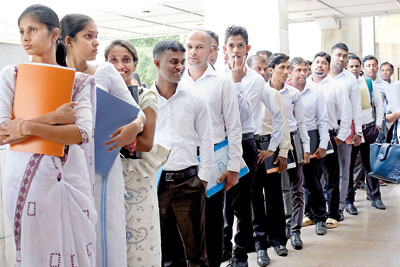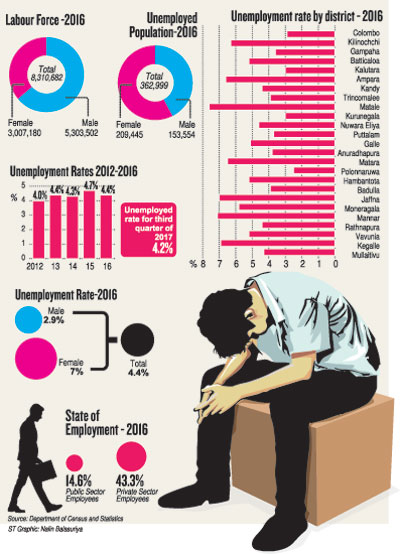News
Have degree, can drive tuk-tuk
Educated beyond the jobs available to them and with skilled work dwindling, more and more youth are trapped in dead-end employment as three-wheeler drivers with little chance of improving their prospects.

Bleak prospects: More than 1,000 applicants flocked to the Supreme Court recently in answer to an advertisement for one post. Pic by Amila Gamage
Meanwhile, the country loses as skilled youth go overseas in greater numbers in search of jobs.
The State Minister for National Policies and Economic Affairs Dr. Harsha De Silva said that in two years the Government had created 430,000 jobs in the service sector in urban areas and in the industrial sector, though he admitted that job creation in some other sectors had fallen short of expectations.
He said that there was a big mismatch in the skills available and the skills required in the market and this needed to be corrected.
Pointing out that only 35 per cent of women were employed in the labour force, the State Minister said the Government was planning to introduce amendments that will allow the labour force to accommodate more women.
Issues such as flexible hours and proper transport needed to be looked into, he said.
Minister De Silva said the Government was also encouraging people to engage in the process of access economy or sharing economy where people share their existing assets and participate in the economy.
“Tourism is one such sector that people can benefit via sharing economy. It allows micro and small enterprises to take part in the growing economy,” he said.
The minister pointed out that in the last budget the Government placed much emphasis on entrepreneurship to allow more people to become entrepreneurs.
Addressing the issue of unemployed graduates, he pointed out that the Government had received more than 40,000 job applications, most of them from Arts graduates.
“Most graduates only focus on acquiring public sector jobs as they find such jobs more lucrative. This attitude must change and graduates must reach out and look at other sectors and industries,” he said.
Educated youth unemployment is the most disappointing aspect of unemployment rates in Sri Lanka, Professor of Economics at the University of Colombo, Sirimal Abeyratne said.
“The country possesses an immense amount of skilled labour but the economy is not expanding enough to absorb the skilled labour into the system,” Prof. Abeyratne said.
Youth unemployment is soaring according to the Census and Statistics Department – from 17.2 per cent in 2012 to 21.6 in 2016, the year of the last published survey.
Youth unemployment is higher among those educated up to GCE Advanced Level and above, with 32.5 per cent of that category unemployed in 2016 compared with 22.4 per cent unemployment for those who were educated up to the Ordinary Level and 16.3 per cent unemployment for youth educated only up to Grade 10.
Prof. Abeyratne said that while in the past there was a high rate of unskilled labour migration the current trend was the migration of skilled labour.
“The high aspirations of people do not meet the available jobs in the market,” he said.
Labour was concentrated in the wrong places, Prof. Abeyratne said: for instance, youths predominated among the one million-plus three-wheeler drivers, and this work allowed no room for skills improvement. This pattern also created a void in the skilled labour force.
Other experts agreed that changes in the local job market had stifled opportunities for youth looking for work.
“The reason for the hike in youth unemployment is the fact that at present the market is not looking for skilled workers,” the Director of Research at the Institute of Policy Studies, Nisha Arunatilake, said.
Ms Arunatilake said companies had not created openings for skilled workers despite the fact that a large number of skilled youth were released into society every year by the education system.
She also said people wasted time and money enrolling in institutions that offered courses and training that did not suit employment needs. Education and training needed to be revamped to give better job prospects, she said.
Ms. Arunatilake pointed to the hurdles faced by women in particular. Female unemployment was 7 per cent in 2016, more than double the male rate. In that year, 209,445 women were unemployed.
“Distance and number of hours are factors that become a concern to the female population because hours must be [fixed] to manage a household. As a result of this, women remain unemployed most of the time,” Ms. Arunatilake said.
The convener of the Unemployed Graduates Association, Ven. Tenne Gnanananda, said there were 53,000 unemployed undergraduates in the country and appealed to the government to formulate policy that would create jobs for educated youth.
“There are many graduates who work as minor staff in organisations such as the garment industry and manpower services for a meagre salary,” he said.
It was reported recently that 68 undergraduates were employed as minor staff in government hospitals. The government has guaranteed to transfer them to better jobs.
Census figures show a slight improvement in employment over the past few years. Unemployment in 2016 was 4.4 per cent and the third quarter of 2017 showed this figure declining to 4.2 per cent. This compares with 4.7 per cent in 2015, 4.3 per cent in 2014 and 4 per cent and 4.4 per cent respectively in 2012 and 2013.
The highest unemployment is in Matale District at 7.6 per cent followed by Mannar District at 7.1 per cent and Jaffna District at 7 per cent.
The Labour Department revealed that last year saw 454,971 new registrations of employees and 6,507 new registrations of employers in the Employees’ Provident Fund (EPF). In 2016, new registrations of employees stood at 620,806 and new employers at 7,178.
BOI Director of Media and Publicity Dilip Samarasinghe said about 493,000 people were directly employed in board enterprises and these projects led to indirect employment for a further two million people.
Most jobs were generated in the sectors of manufacture, infrastructure and services, he said.
“BOI enterprises employ some of the most skilled workers of the country and these contribute around 60 per cent of the export earnings of Sri Lanka. The impact is considerable in terms of export earnings and technical transfer,” Mr. Samarasinghe said.

